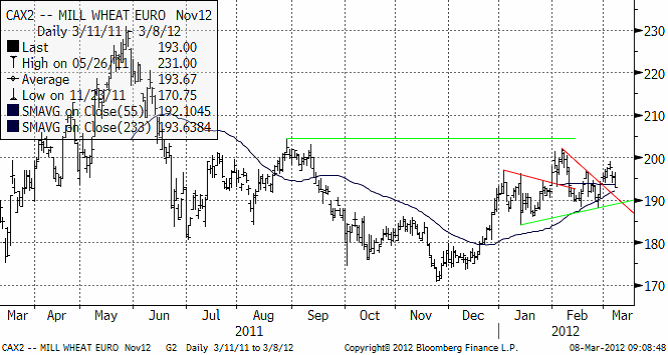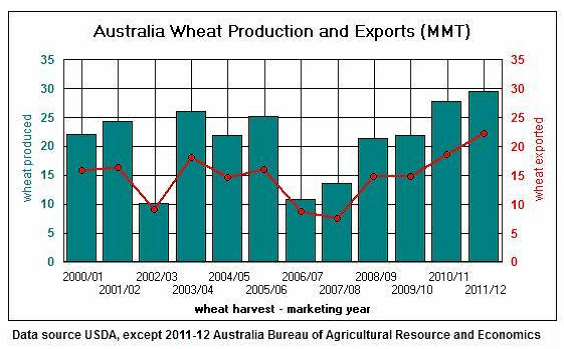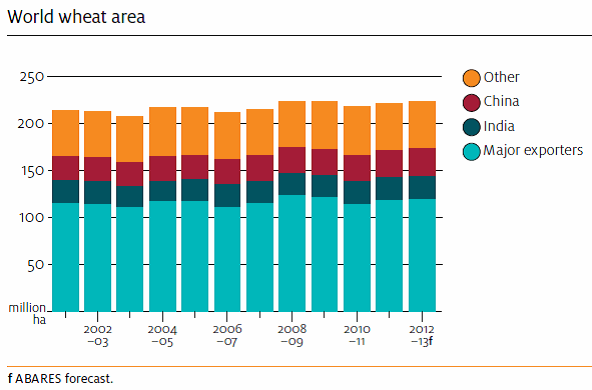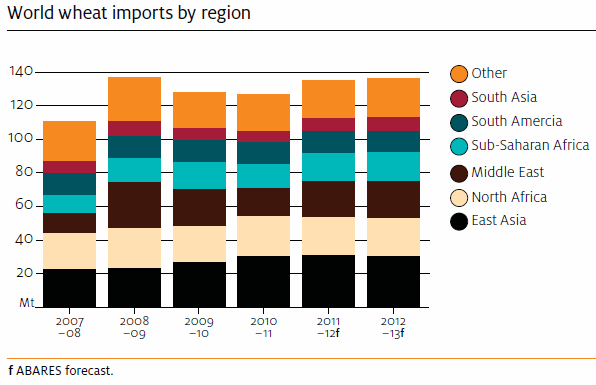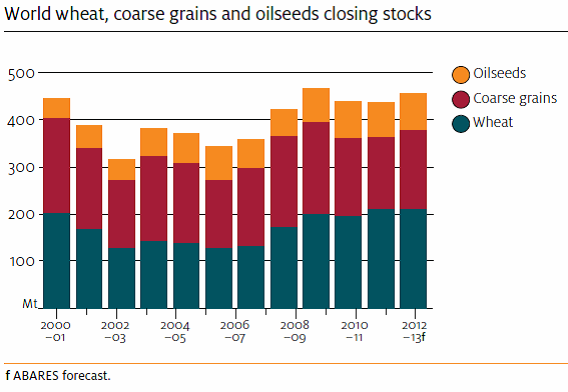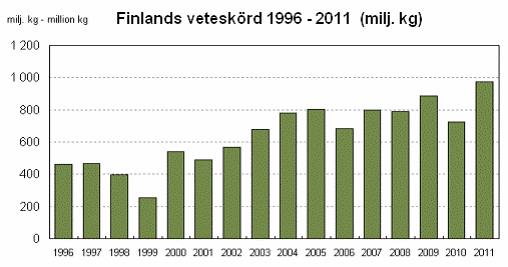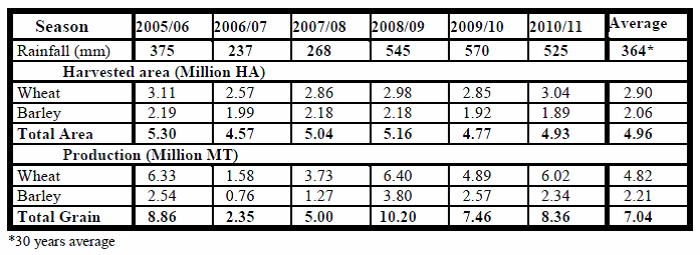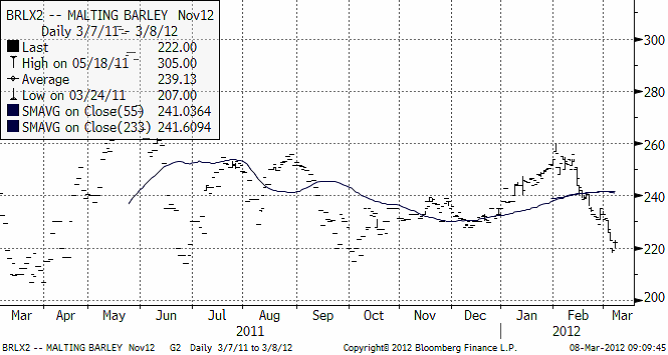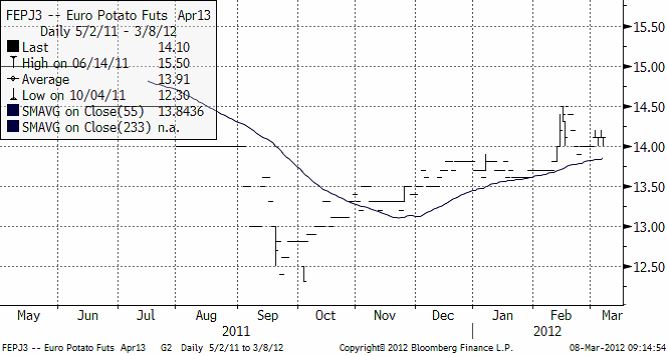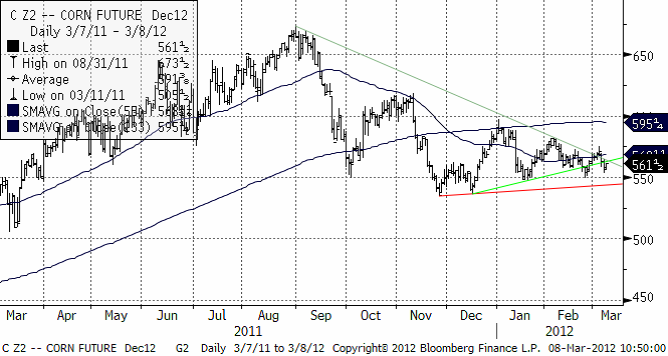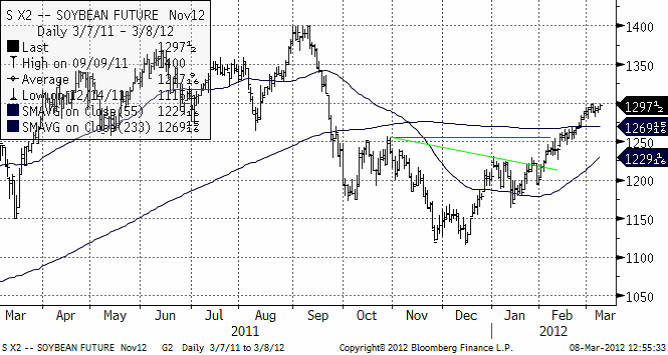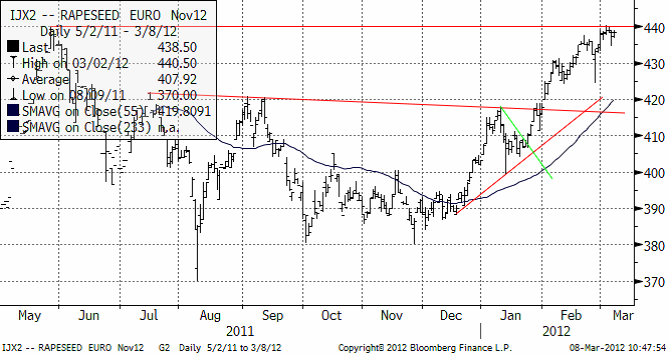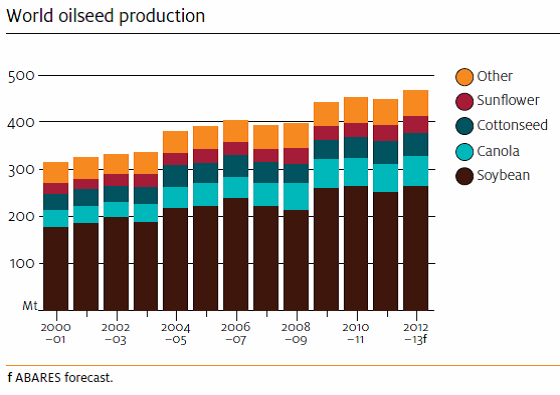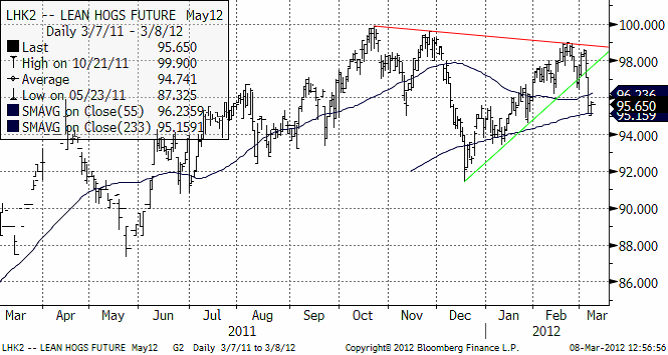Analys
SEB – Jordbruksprodukter, vecka 10 2012
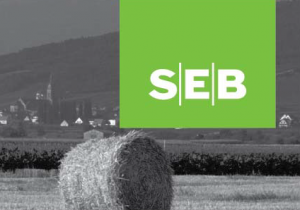 Inledning
Inledning
Den senaste veckan har varit lugn med överlag oförändrade eller något lägre priser på jordbruksprodukter. I morgon fredag klockan 14:30 släpps WASDE för mars och det brukar innebära lite större prisrörelser. Vi tror att rörelserna då generellt sett blir nedåtriktade. ABARES har släppt en stor rapport, som vi lagt i centrum för det här veckobrevet, som annars är lite kortare i samklang med den mycket lugna marknaden den senaste veckan.
Vete
Novemberterminen på Matif har backat nedåt efter att marknaden misslyckats med att nå över 200 euro per ton.
ABARES förutspår att veteskörden i Australien för 2011/12 kommer att uppgå till rekordhöga 29.5 mt, vilket skulle vara nytt rekord för andra året i rad då förra årets skörd uppgick till 27.9 mt.
I sin prognos för 2012/13 skriver ABARES att trots en förväntad ökning av arealen för vete i världen uppskattas den globala veteproduktionen minska med 2 procent till ca 682 mt för 2012/13, vilket är i linje med IGC’s estimat förra månaden på 680 mt.
I USA förväntas vete produktionen att öka med 6 procent till omkring 58 mt, som ett resultat av högre areal och en återgång till en genomsnittlig avkastning efter dåliga säsongsmässiga förhållanden under 2011/12. Veteproduktionen i Canada förväntas också öka med 2 procent till ca 26 mt.
Inom den europeiska unionen beräknas veteproduktionen för 2012/13 att stiga med 2 procent till ca 140 mt. Torrt väder i vissa regioner har lett till minskad sådd areal av raps, till förmån för höstvete som sås senare.
I Kina förväntas den totala produktionen av höst- och vårvete uppgå till ca 120 mt, en ökning med 2 procent, medan produktionen i Indien, som är världens tredje största producent av vete efter EU och Kina, förväntas minska med 4 procent till ca 83 mt.
I Argentina förväntas produktionen bli i stort sett oförändrad runt 13 mt.
Produktionen av vete i Ryssland förväntas öka med 5 procent till ca 59 mt för 2012/13 till följd av tillräcklig nederbörd under sådden samt ett fullgott snötäcke under vintern. Produktionen i Ukraina väntas däremot minska till följd av höstens torka som drabbade de västra delarna av landet. I Kazakstan förväntas produktionen att falla med 31 procent till ca 16 mt. Väderförhållandena föregående säsong var exceptionellt gynnsamma för veteproduktionen där lantbrukare fick rekordavkastningar som låg nästan 60 procent över föregående 10-års genomsnitt.
Australiens egen vete produktion förväntas falla med 13 procent till ca 26 mt 2012/13 eftersom arealen för vete tros minska med 3 procent till 13.7 m hektar då man estimerar att vetepriset, i jämförelse med andra större grödor, blir mindre attraktivt. Exporten av australiensiskt vete förväntas bli i stort sett oförändrar runt 21 mt.
Den globala konsumtionen av vete beräknas öka marginellt till 681 mt under 2012/13 och beror till stor del på en ökad konsumtion av vete som human föda i takt med en ökad befolkningstillväxt i världen.
Konsumtionen av fodervete förväntas kvarstå på en hög nivå i förhållande till de senaste åren, men beräknas falla från den rekordhöga nivån under 2011/12 då användningen ökade som ett resultat av höga priser på majs i förhållande till fodervete. Östasien står för en stor del av den ökade konsumtion av fodervete, där efterfrågan delvis har tillgodosetts genom import av australiensiskt fodervete från 2010/11 års regndrabbade skörd.
Handel med vete under 2012/13 beräknas stiga marginellt till ca 136 mt, till stor del beroende på höga lager och ytterligare en säsong av en relativt hög estimerad produktion i de stora exportländerna. Exporten förväntas bli oförändrad för de flesta stora exportländerna utom i USA där exporten bedöms öka med 4 procent till ca 25 mt som en följ av en förväntad högre produktion. Den globala importen av vete förväntas stiga marginellt i linje med exporten.
Globala utgående lager för vete 2012/13 förväntas öka med 1 procent till ca 210 mt till följd av att produktionen överträffar konsumtionen. Lagren i de flesta stora exportländerna förväntas bli i stort sett oförändrade med undantag av USA där de förväntas öka med 10 procent till ca 28 mt med tanke på den förväntade ökningen i produktionen.
Från HGCA i Storbritannien rapporteras det att vädret under vintern 2011/12 har varit varmare än genomsnittet för en stor del av perioden, med undantag av en kort men mycket kall period i början av februari. Nederbörden under samma tid har haft stora regionala skillnader där Skottland, Wales och norra England fick en mycket blöt höst och vinter medan stora delar av södra, centrala och östra England sedan i september endast har fått 70-80% av den, för den här tiden, normala nederbörden.
Grödorna har utvecklats väl under vintern, även om det blöta vädret i Skottland har inneburit förseningar i tillväxtfasen. Det milda vädret kan dock komma att orsaka sjukdomar, särskilt mjöldagg och rost hos spannmål och det finns en stor risk för ljus bladfläcksjuka hos raps. För vårt östra grannland Finland uppgick den totala spannmålsskörden för 2011 till ca 3,7 mt enligt Tike. För samtliga spannmålsslag ökade odlingsarealerna och hektarskördarna från 2010 med vete i spetsen där odlingsarealen ökade med en femtedel jämfört med året innan och skörden uppgick till ca 975 000 ton, vilket var den hittills största i Finland. Produktionen av höstvete steg nästan till det dubbla (173 000 ton) och produktionen av vårvete ökade med 26 procent till 801 000 ton. För både vår- och höstvete var mängderna av kvarnduglig skörd de största på flera årtionden.
Tittar vi på de baltiska länderna så säger preliminära uppgifter att spannmålsproduktionen i Estland uppgick till 771 900 ton under 2011, vilket är 14% mer än föregående år. Av den totala produktionen var 360 400 ton vete, 294 400 ton korn och 30 900 ton råg. Sådd areal för vete uppgick till 128 500 hektar, vilket är den största de senaste trettio åren.
Produktionen av raps och rybs uppgick till 142 600 ton, vilket är 10% mer än 2010 och också den största skörden under de senaste två decennierna.
I Lettland uppgick spannmålsskörden till 1.4 mt under förra året, vilket är något lägre än skörden 2010, till följd av minskad avkastning och minskad produktion av höstgrödor. Året var däremot gynnsamt för vårgrödorna där bl.a produktionen av vårvete ökade rejält.
Litauen fick däremot en högre spannmålsskörd under 2011 och den uppgick till 3.3 mt jämfört med 2.9 mt under 2010. Den totala produktionen av vete ökade till 3.2 mt från 2.8 mt året innan. Landets rapsproduktion uppgick till 484 300 ton jämfört med 416 700 ton under 2010.
Marockos grödor, som fick en sen start pga av det försenade regnet – i vissa områden avslutades sådden så sent som i slutet av december, befinner sig nu i en kritisk fas som kommer att avgöra 2011/12 års skörd. Förutom bristen på nederbörd och den sena sådden av vete och korn, har ovanligt låga temperaturer påverkat groning och hämmat grödornas utveckling. Den stora oron över bristen på regn och dess påverkan på jordbruket fick den marockanska kungen, the Commander of the Faithful, att uppmana sitt folk att be om regn och regn böner ägde rum den 6 januari i flera regioner i landet.
Det efterlängtade regnet kom också tio dagar senare, men med mindre intensitet än vad man hade hoppats på. Nederbörden från 1 september till 17 januari var ca 27 procent lägre än genomsnittet och 43 procent lägre jämfört med föregående år. Marockos import av vete per mitten av januari uppskattades till 1.18 mt, en nedjustering med 10 procent jämfört med samma period förra året, där Frankrike är den största leverantören med 77 procent, medan Ryssland och Ukraina står för 9 respektive 7 procent. Uttalandet om att Marocko kan komma att importera 1-1.1 mt vete under perioden mars-maj i år efter att regeringen beslutat att häva importtullar för vete under två månaders tid gav därför stöd till kvarnvetet på Matif. Tabellen nedan visar skördad areal och produktion av vete och korn i Marocko under de senaste 6 åren:
Även i Portugal ber nu lantbrukare om ett mirakel efter att landet har genomlidit den torraste februari månad på 80 år där torkan förstör betesmarker och leder till skogsbränder, vilket förvärrar landets ekonomiska kris. Det nyckfulla vädret förväntas dessutom hålla sig till slutet på mars, vilket skulle förvärra en torka som redan nu klassificeras som svår och extrem och det torra kallt väder på natten och värme under dagen förstör grödorna.
Maltkorn
Novemberkontraktet på maltkorn har fortsatt att falla med förnyad styrka ner mot nivåer kring 200 till 220 där marknaden tidigare har funnit stöd. Vi förväntar oss att prisfallet även denna gång hejdar sig åtminstone temporärt på den här nivån. Om man är ute för att prissäkra kan man därför gott avvakta något för att kanske kunna sälja på exempelvis 230 euro igen inom kort. Detta är dock inte helt säkert, förstås.
Korn är fortfarande det mest odlade spannmålsslaget i Finland och enligt Tike uppgick skörden till omkring 1.5 mt för 2011, vilket är en ökning med 13 procent jämfört med året innan. Trots ökningen var den totala kornskörden den näst lägsta på 2000-talet. Merparten är foderkorn, men 300 000 ton utgörs av maltkorn där produktionen ökade med en knapp tredjedel i huvudsak till följd av ökad hektarskörd men också ökad odlingsareal. Även i Finland hade man dock kvalitetsproblem med maltkorn som inte uppfyllde kraven på kornstorlek och proteinhalt.
Potatis
Priset på industripotatis för leverans nästa år är oförändrat. För leverans i år har priset handlats ner ungefär 5%, dvs mer av samma sak som präglat marknadsföringsåret hela tiden.
Majs
Majspriset gjorde ett ”falskt” tekniskt utbrott uppåt, efter att ha gjort ett likaledes ”falskt” utbrott nedåt. Därför är det omöjligt att från teknisk synvinkel ha någon bestämd uppfattning om vare sig uppåt eller nedåt. Vi får ha en neutral rekommendation för tillfället
Sojabönor
Novemberkontraktet verkar ha stött på säljare på 13 dollar per bushel. Priset står just nu och väger. En rekyl nedåt är naturligtvis inte osannolikt.
Vi skulle vilja sälja november på den här nivån vid 13 dollar per bushel.
Raps
Novemberkontraktet testade 440 euro, men orkade inte igenom. Vi tror att ur teknisk synvinkel, det är en god idé att sälja på den här nivån. Skulle dock priset gå över 440 bör man köpa tillbaka.
Enligt ABARES rapport beräknas den globala rapsproduktionen att öka med 7 procent under 2012/13 till 64 mt, vilket återspeglar av en återhämtning i EU till följd av förbättrade säsongsmässiga förhållanden.
Globala utgående lager för 2012/13 förväntas öka med 11 procent till 4.9 mt ton. I Kanada, beräknas produktionen av raps att öka med 6 procent till en rekordnivå på 14.9 mt.
Ogynnsamma väderförhållanden under förra säsongen begränsade då sådden. Sådd areal för 2012/13 beräknas öka med 12 procent till 7.7 m hektar och det är denna ökning i kombination med prognoser för en god avkastning som förväntas driva upp produktionen för den här säsongen.
Raps / canola produktionen i EU förväntas öka med 8 procent till 20.5 mt för 2012/13. Medan vissa länder inom unionen har drabbats av torka, så uppskattas en återgång till mer normala säsongsmässiga förhållanden i de flesta länder att resultera i en 4-procentig ökning av sådd areal till ca 7 m hektar. De dåliga väderförhållandena under 2011/12 resulterade i att avkastningen sjönk till ett
10-års lägsta men i motsats till detta så beräknas avkastningen för denna säsong att återgå till genomsnittet.
EU förväntas också importera mindre raps / canola till följd av en högre inhemsk produktion. Arealen för australiensisk canola förväntas öka med 5 procent under 2012/13 till 1.8 m hektar, som en följd av attraktiva priser och en stark global efterfrågan på oljeväxter.
Produktionen estimeras öka med 5 procent till ca 2.9 mt och baseras på fortsatt hög avkastning efter torkan som drabbade grödan i västra Australien under 2010/11.
Enligt statliga COFCO (China National Cereals, Oils and Foodstuffs Corporation) kommer Kinas rapsproduktion för 2012 förväntas uppgå till 13 -14 miljoner ton, vilket är en liten ökning från tidigare estimat. Analysfirman Oil World har en prognos på att Kinas raps / canola skörd kommer att uppgå till 11,6 mt för 2012, vilket är en nedjustering från 12.2 mt 2010/11.
Kina är världens största importör av sojabönor och har ökat sin import av oljeväxter, inklusive sojabönor och raps, som krossas till mjöl och matoljor, för att möta den ökade efterfrågan. I Finland minskade odlingsarealen för raps under 2011 med 10 procent, men framförallt minskade odlingsarealen för rybs betydligt, -46 procent, jämfört med rekordåret 2010. Hektarskörden för rybs ökade endast marginellt, men den för raps ökade med närmare 40 procent. Den totala skörden uppgick till ca 1.15 mt under 2011 enligt Tike, en minskning med 36 procent jämfört med rekordskörden 2010.
Gris
Majkontraktet som vi säljrekommenderade för en vecka sedan föll mycket riktigt väldigt kraftigt. Trenden är allt jämnt nedåtriktad. Potentialen är i första hand ett fall ner mot 94 och i andra hand hela vägen ner till decemberbotten på 92.
[box]SEB Veckobrev Jordbruksprodukter är producerat av SEB Merchant Banking och publiceras i samarbete och med tillstånd på Råvarumarknaden.se[/box]
Disclaimer
The information in this document has been compiled by SEB Merchant Banking, a division within Skandinaviska Enskilda Banken AB (publ) (“SEB”).
Opinions contained in this report represent the bank’s present opinion only and are subject to change without notice. All information contained in this report has been compiled in good faith from sources believed to be reliable. However, no representation or warranty, expressed or implied, is made with respect to the completeness or accuracy of its contents and the information is not to be relied upon as authoritative. Anyone considering taking actions based upon the content of this document is urged to base his or her investment decisions upon such investigations as he or she deems necessary. This document is being provided as information only, and no specific actions are being solicited as a result of it; to the extent permitted by law, no liability whatsoever is accepted for any direct or consequential loss arising from use of this document or its contents.
About SEB
SEB is a public company incorporated in Stockholm, Sweden, with limited liability. It is a participant at major Nordic and other European Regulated Markets and Multilateral Trading Facilities (as well as some non-European equivalent markets) for trading in financial instruments, such as markets operated by NASDAQ OMX, NYSE Euronext, London Stock Exchange, Deutsche Börse, Swiss Exchanges, Turquoise and Chi-X. SEB is authorized and regulated by Finansinspektionen in Sweden; it is authorized and subject to limited regulation by the Financial Services Authority for the conduct of designated investment business in the UK, and is subject to the provisions of relevant regulators in all other jurisdictions where SEB conducts operations. SEB Merchant Banking. All rights reserved.
Analys
More weakness and lower price levels ahead, but the world won’t drown in oil in 2026

Some rebound but not much. Brent crude rebounded 1.5% yesterday to $65.47/b. This morning it is inching 0.2% up to $65.6/b. The lowest close last week was on Thursday at $64.11/b.

The curve structure is almost as week as it was before the weekend. The rebound we now have gotten post the message from OPEC+ over the weekend is to a large degree a rebound along the curve rather than much strengthening at the front-end of the curve. That part of the curve structure is almost as weak as it was last Thursday.
We are still on a weakening path. The message from OPEC+ over the weekend was we are still on a weakening path with rising supply from the group. It is just not as rapidly weakening as was feared ahead of the weekend when a quota hike of 500 kb/d/mth for November was discussed.
The Brent curve is on its way to full contango with Brent dipping into the $50ies/b. Thus the ongoing weakening we have had in the crude curve since the start of the year, and especially since early June, will continue until the Brent crude oil forward curve is in full contango along with visibly rising US and OECD oil inventories. The front-month Brent contract will then flip down towards the $60/b-line and below into the $50ies/b.
At what point will OPEC+ turn to cuts? The big question then becomes: When will OPEC+ turn around to make some cuts? At what (price) point will they choose to stabilize the market? Because for sure they will. Higher oil inventories, some more shedding of drilling rigs in US shale and Brent into the 50ies somewhere is probably where the group will step in.
There is nothing we have seen from the group so far which indicates that they will close their eyes, let the world drown in oil and the oil price crash to $40/b or below.
The message from OPEC+ is also about balance and stability. The world won’t drown in oil in 2026. The message from the group as far as we manage to interpret it is twofold: 1) Taking back market share which requires a lower price for non-OPEC+ to back off a bit, and 2) Oil market stability and balance. It is not just about 1. Thus fretting about how we are all going to drown in oil in 2026 is totally off the mark by just focusing on point 1.
When to buy cal 2026? Before Christmas when Brent hits $55/b and before OPEC+ holds its last meeting of the year which is likely to be in early December.
Brent crude oil prices have rebounded a bit along the forward curve. Not much strengthening in the structure of the curve. The front-end backwardation is not much stronger today than on its weakest level so far this year which was on Thursday last week.

The front-end backwardation fell to its weakest level so far this year on Thursday last week. A slight pickup yesterday and today, but still very close to the weakest year to date. More oil from OPEC+ in the coming months and softer demand and rising inventories. We are heading for yet softer levels.

Analys
A sharp weakening at the core of the oil market: The Dubai curve

Down to the lowest since early May. Brent crude has fallen sharply the latest four days. It closed at USD 64.11/b yesterday which is the lowest since early May. It is staging a 1.3% rebound this morning along with gains in both equities and industrial metals with an added touch of support from a softer USD on top.

What stands out the most to us this week is the collapse in the Dubai one to three months time-spread.
Dubai is medium sour crude. OPEC+ is in general medium sour crude production. Asian refineries are predominantly designed to process medium sour crude. So Dubai is the real measure of the balance between OPEC+ holding back or not versus Asian oil demand for consumption and stock building.
A sharp weakening of the front-end of the Dubai curve. The front-end of the Dubai crude curve has been holding out very solidly throughout this summer while the front-end of the Brent and WTI curves have been steadily softening. But the strength in the Dubai curve in our view was carrying the crude oil market in general. A source of strength in the crude oil market. The core of the strength.
The now finally sharp decline of the front-end of the Dubai crude curve is thus a strong shift. Weakness in the Dubai crude marker is weakness in the core of the oil market. The core which has helped to hold the oil market elevated.
Facts supports the weakening. Add in facts of Iraq lifting production from Kurdistan through Turkey. Saudi Arabia lifting production to 10 mb/d in September (normal production level) and lifting exports as well as domestic demand for oil for power for air con is fading along with summer heat. Add also in counter seasonal rise in US crude and product stocks last week. US oil stocks usually decline by 1.3 mb/week this time of year. Last week they instead rose 6.4 mb/week (+7.2 mb if including SPR). Total US commercial oil stocks are now only 2.1 mb below the 2015-19 seasonal average. US oil stocks normally decline from now to Christmas. If they instead continue to rise, then it will be strongly counter seasonal rise and will create a very strong bearish pressure on oil prices.
Will OPEC+ lift its voluntary quotas by zero, 137 kb/d, 500 kb/d or 1.5 mb/d? On Sunday of course OPEC+ will decide on how much to unwind of the remaining 1.5 mb/d of voluntary quotas for November. Will it be 137 kb/d yet again as for October? Will it be 500 kb/d as was talked about earlier this week? Or will it be a full unwind in one go of 1.5 mb/d? We think most likely now it will be at least 500 kb/d and possibly a full unwind. We discussed this in a not earlier this week: ”500 kb/d of voluntary quotas in October. But a full unwind of 1.5 mb/d”
The strength in the front-end of the Dubai curve held out through summer while Brent and WTI curve structures weakened steadily. That core strength helped to keep flat crude oil prices elevated close to the 70-line. Now also the Dubai curve has given in.

Brent crude oil forward curves

Total US commercial stocks now close to normal. Counter seasonal rise last week. Rest of year?

Total US crude and product stocks on a steady trend higher.

Analys
OPEC+ will likely unwind 500 kb/d of voluntary quotas in October. But a full unwind of 1.5 mb/d in one go could be in the cards

Down to mid-60ies as Iraq lifts production while Saudi may be tired of voluntary cut frugality. The Brent December contract dropped 1.6% yesterday to USD 66.03/b. This morning it is down another 0.3% to USD 65.8/b. The drop in the price came on the back of the combined news that Iraq has resumed 190 kb/d of production in Kurdistan with exports through Turkey while OPEC+ delegates send signals that the group will unwind the remaining 1.65 mb/d (less the 137 kb/d in October) of voluntary cuts at a pace of 500 kb/d per month pace.

Signals of accelerated unwind and Iraqi increase may be connected. Russia, Kazakhstan and Iraq were main offenders versus the voluntary quotas they had agreed to follow. Russia had a production ’debt’ (cumulative overproduction versus quota) of close to 90 mb in March this year while Kazakhstan had a ’debt’ of about 60 mb and the same for Iraq. This apparently made Saudi Arabia angry this spring. Why should Saudi Arabia hold back if the other voluntary cutters were just freeriding? Thus the sudden rapid unwinding of voluntary cuts. That is at least one angle of explanations for the accelerated unwinding.
If the offenders with production debts then refrained from lifting production as the voluntary cuts were rapidly unwinded, then they could ’pay back’ their ’debts’ as they would under-produce versus the new and steadily higher quotas.
Forget about Kazakhstan. Its production was just too far above the quotas with no hope that the country would hold back production due to cross-ownership of oil assets by international oil companies. But Russia and Iraq should be able to do it.
Iraqi cumulative overproduction versus quotas could reach 85-90 mb in October. Iraq has however steadily continued to overproduce by 3-5 mb per month. In July its new and gradually higher quota came close to equal with a cumulative overproduction of only 0.6 mb that month. In August again however its production had an overshoot of 100 kb/d or 3.1 mb for the month. Its cumulative production debt had then risen to close to 80 mb. We don’t know for September yet. But looking at October we now know that its production will likely average close to 4.5 mb/d due to the revival of 190 kb/d of production in Kurdistan. Its quota however will only be 4.24 mb/d. Its overproduction in October will thus likely be around 250 kb/d above its quota with its production debt rising another 7-8 mb to a total of close to 90 mb.
Again, why should Saudi Arabia be frugal while Iraq is freeriding. Better to get rid of the voluntary quotas as quickly as possible and then start all over with clean sheets.
Unwinding the remaining 1.513 mb/d in one go in October? If OPEC+ unwinds the remaining 1.513 mb/d of voluntary cuts in one big go in October, then Iraq’s quota will be around 4.4 mb/d for October versus its likely production of close to 4.5 mb/d for the coming month..
OPEC+ should thus unwind the remaining 1.513 mb/d (1.65 – 0.137 mb/d) in one go for October in order for the quota of Iraq to be able to keep track with Iraq’s actual production increase.
October 5 will show how it plays out. But a quota unwind of at least 500 kb/d for Oct seems likely. An overall increase of at least 500 kb/d in the voluntary quota for October looks likely. But it could be the whole 1.513 mb/d in one go. If the increase in the quota is ’only’ 500 kb/d then Iraqi cumulative production will still rise by 5.7 mb to a total of 85 mb in October.
Iraqi production debt versus quotas will likely rise by 5.7 mb in October if OPEC+ only lifts the overall quota by 500 kb/d in October. Here assuming historical production debt did not rise in September. That Iraq lifts its production by 190 kb/d in October to 4.47 mb/d (August level + 190 kb/d) and that OPEC+ unwinds 500 kb/d of the remining quotas in October when they decide on this on 5 October.

-

 Nyheter4 veckor sedan
Nyheter4 veckor sedanMahvie Minerals i en guldtrend
-

 Analys4 veckor sedan
Analys4 veckor sedanVolatile but going nowhere. Brent crude circles USD 66 as market weighs surplus vs risk
-

 Nyheter4 veckor sedan
Nyheter4 veckor sedanAktier i guldbolag laggar priset på guld
-

 Nyheter3 veckor sedan
Nyheter3 veckor sedanKinas elproduktion slog nytt rekord i augusti, vilket även kolkraft gjorde
-

 Nyheter3 veckor sedan
Nyheter3 veckor sedanTyskland har så höga elpriser att företag inte har råd att använda elektricitet
-

 Nyheter4 veckor sedan
Nyheter4 veckor sedanGuld når sin högsta nivå någonsin, nu även justerat för inflation
-

 Nyheter4 veckor sedan
Nyheter4 veckor sedanDet stigande guldpriset en utmaning för smyckesköpare
-

 Analys4 veckor sedan
Analys4 veckor sedanWaiting for the surplus while we worry about Israel and Qatar


